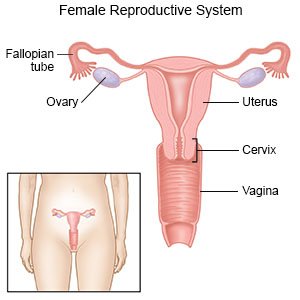Female Infertility
Medically reviewed by Drugs.com. Last updated on Apr 6, 2025.
What is female infertility?
Female infertility means you are not pregnant after 1 year of regular unprotected sex with the same partner. If you are older than 35, infertility is after 6 months of regular unprotected sex with the same partner. Infertility may also mean that you get pregnant more than 1 time but always have miscarriages or stillbirths.
 |
How is the cause of female infertility diagnosed?
Your healthcare provider may ask about your period, past pregnancies, length of infertility, or sexual history. Your provider will also do a physical exam. You may also need any of the following:
- Blood tests are used to check your hormone levels.
- X-ray, ultrasound, or MRI pictures may show a problem or infection in your reproductive organs. Do not enter the MRI room with anything metal. The MRI machine uses a powerful magnet. Metal may cause serious injury from the magnet.
- A hysteroscopy is a procedure to find problems in your uterus that may be preventing pregnancy. Your provider will insert a scope through your cervix and into your uterus. Tools inserted through the scope may be used to remove scar tissue, growths such as polyps or fibroids, or a sample of tissue.
How is female infertility treated?
Treatment depends on the cause:
- Medicines may be used to cause ovulation or to release more hormones that stimulate ovulation. Some medicines change when you ovulate, especially if you do not ovulate every month. You may need medicine to lower your male hormone levels if you have insulin resistance or polycystic ovary syndrome (PCOS).
- Intrauterine insemination is a procedure used to put sperm directly into your uterus. It may also be called artificial insemination. This procedure may be used if your partner has male factor infertility. It may also be used if the natural mucus around your cervix is too thick to let sperm pass. You may be given medicines that cause ovulation before you have this procedure.
- Assisted reproductive technology (ART) can be done in several ways. An unfertilized egg may be placed into your fallopian tube along with sperm. This allows fertilization to happen inside your body. Your eggs may be removed and fertilized by sperm outside your body. Then the fertilized eggs (embryos) are put back into your uterus or fallopian tubes. Your ability to become pregnant is increased when more than one embryo is used. Sometimes all or several of the embryos attach. You may have 2 or more babies if this happens. Your obstetrician can tell you more about this risk.
- Surgery may be used to find the cause of your infertility or to fix a problem preventing pregnancy. Endometrial tissues that are growing in the wrong places may be removed. Healthcare providers may also repair blockages or other problems in your fallopian tubes.
Treatment options
The following list of medications are related to or used in the treatment of this condition.
What can I do to increase my fertility?
- Create a healthy lifestyle. Talk to your healthcare provider about a healthy weight for you. You may develop uterine fibroids or an ovulation disorder if your weight is too high or too low. Your provider can help you create healthy meal and exercise plans, if needed. Do not drink alcohol, smoke cigarettes, or use illegal drugs. Any of these can cause infertility. Ask your provider for information if you need help quitting.
- Ask about ways to manage stress. Stress can make pregnancy more difficult. Stress can be hard to manage, especially if infertility is causing the stress. Stress can become worse the longer infertility continues. Try to find ways to help yourself relax. Examples include going for a walk, getting a massage, and talking with a friend. A regular sleep schedule can also help lower stress. Talk to your provider if you continue to have problems managing stress.
Where can I find support and more information?
- International Council on Infertility Information Dissemination
P.O. Box 6836
Arlington , VA 22206
Phone: 1- 703 - 379-9178
Web Address: http://www.inciid.org
- RESOLVE The National Infertility Association
1760 Old Meadow Rd, Ste 500
McLean , VA 22102
Phone: 1- 703 - 556-7172
Web Address: www.resolve.org
Care Agreement
You have the right to help plan your care. Learn about your health condition and how it may be treated. Discuss treatment options with your healthcare providers to decide what care you want to receive. You always have the right to refuse treatment. The above information is an educational aid only. It is not intended as medical advice for individual conditions or treatments. Talk to your doctor, nurse or pharmacist before following any medical regimen to see if it is safe and effective for you.© Copyright Merative 2025 Information is for End User's use only and may not be sold, redistributed or otherwise used for commercial purposes.
Learn more about Female Infertility
Treatment options
Symptoms and treatments
Further information
Always consult your healthcare provider to ensure the information displayed on this page applies to your personal circumstances.
